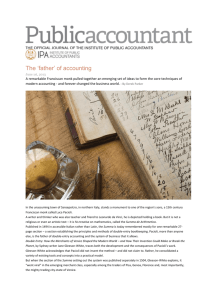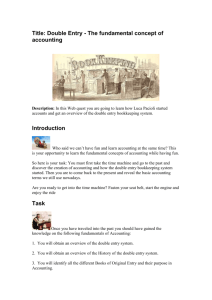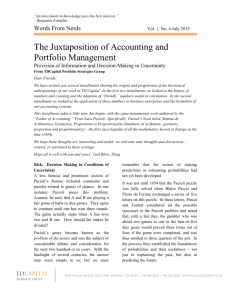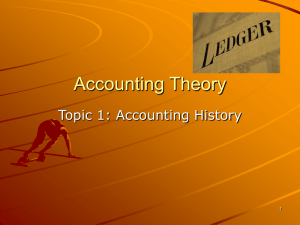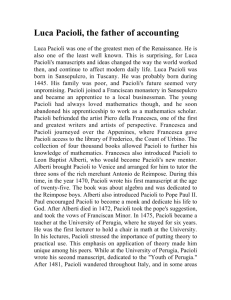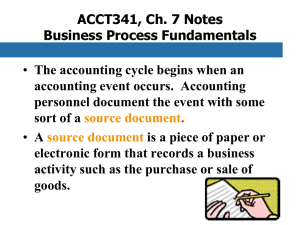Read more of Words from Nerds Vol. 1, No. 3
advertisement
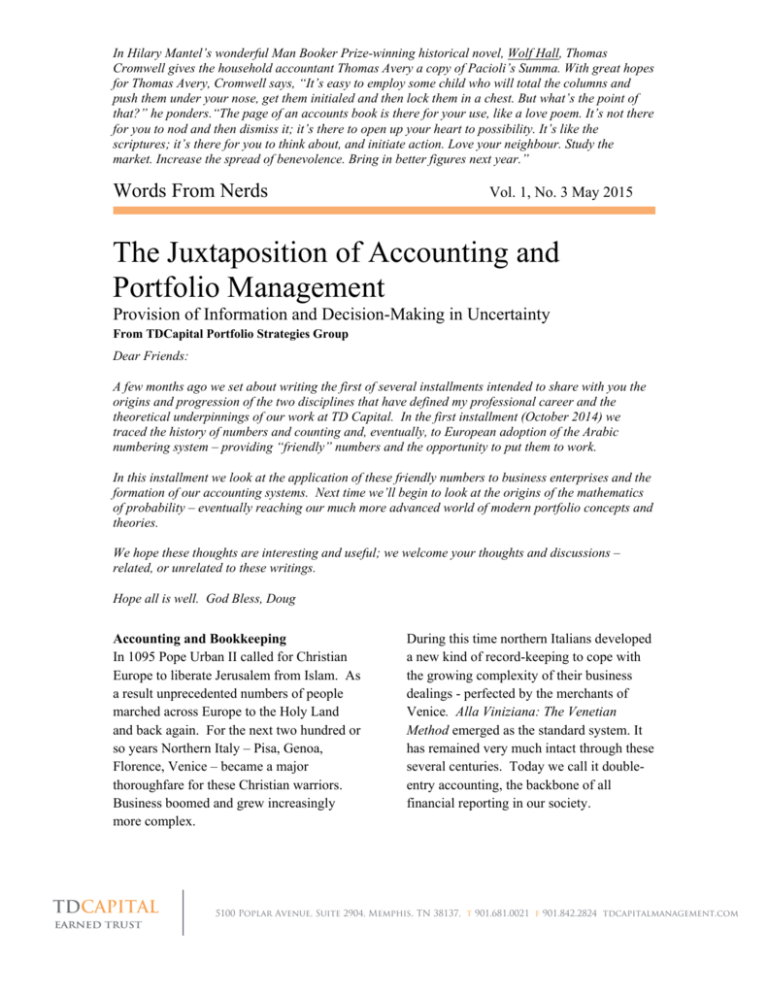
In Hilary Mantel’s wonderful Man Booker Prize-winning historical novel, Wolf Hall, Thomas Cromwell gives the household accountant Thomas Avery a copy of Pacioli’s Summa. With great hopes for Thomas Avery, Cromwell says, “It’s easy to employ some child who will total the columns and push them under your nose, get them initialed and then lock them in a chest. But what’s the point of that?” he ponders.“The page of an accounts book is there for your use, like a love poem. It’s not there for you to nod and then dismiss it; it’s there to open up your heart to possibility. It’s like the scriptures; it’s there for you to think about, and initiate action. Love your neighbour. Study the market. Increase the spread of benevolence. Bring in better figures next year.” Words From Nerds Vol. 1, No. 3 May 2015 The Juxtaposition of Accounting and Portfolio Management Provision of Information and Decision-Making in Uncertainty From TDCapital Portfolio Strategies Group Dear Friends: A few months ago we set about writing the first of several installments intended to share with you the origins and progression of the two disciplines that have defined my professional career and the theoretical underpinnings of our work at TD Capital. In the first installment (October 2014) we traced the history of numbers and counting and, eventually, to European adoption of the Arabic numbering system – providing “friendly” numbers and the opportunity to put them to work. In this installment we look at the application of these friendly numbers to business enterprises and the formation of our accounting systems. Next time we’ll begin to look at the origins of the mathematics of probability – eventually reaching our much more advanced world of modern portfolio concepts and theories. We hope these thoughts are interesting and useful; we welcome your thoughts and discussions – related, or unrelated to these writings. Hope all is well. God Bless, Doug Accounting and Bookkeeping In 1095 Pope Urban II called for Christian Europe to liberate Jerusalem from Islam. As a result unprecedented numbers of people marched across Europe to the Holy Land and back again. For the next two hundred or so years Northern Italy – Pisa, Genoa, Florence, Venice – became a major thoroughfare for these Christian warriors. Business boomed and grew increasingly more complex. During this time northern Italians developed a new kind of record-keeping to cope with the growing complexity of their business dealings - perfected by the merchants of Venice. Alla Viniziana: The Venetian Method emerged as the standard system. It has remained very much intact through these several centuries. Today we call it doubleentry accounting, the backbone of all financial reporting in our society. TDCAPITAL 5100 Poplar Avenue, Suite 2904, Memphis, TN 38137, t 901.681.0021 f 901.842.2824 tdcapitalmanagement.com Fra Luca Pacioli Considered the “father” of accounting is a Franciscan monk and consummate Renaissance man – Luca Pacioli. He was born near Florence (Sansepolcro) in the 1440’s and published the first treatise on Venetian accounting in 1494. Pacioli’s early life was likely influenced by the artist, also of Sansepolcro, Piero della Francesca. Piero may have taught Pacioli mathematics, or he may have provided access to the nearby library of Frederico, Count of Urbino. Whatever the circumstances, Pacioli’s educational development seems to include a blend of theoretical mathematics from the Greek tradition coupled with practical applications consistent with the needs of commerce. Pacioli was lucky, opportunistic and brilliant. An extensive biography of Pacioli’s life is beyond the scope of this paper, but a somewhat chronologically accurate series of highlights follows: • At age nineteen traveled to Venice (the New York of the day) and took up a post of tutor to the three sons of a wealthy fur merchant named Rompiasi. He tutored, continued his mathematical studies, and gained commercial (and bookkeeping) experience working as an agent for Rompiasi. • Around 1470 he traveled to Rome with Alberti, the great Florentine Humanist and architect. Alberti became his mentor and guide to the inner sanctum of Rome. Pacioli was likely introduced to Pope Paul II, and later to the Pope’s great-nephew who became Pope Julius II and Pacioli’s patron. He was probably given access to the Vatican Library and began contemplating his mathematical encyclopedia. • Alberti died in 1472 and Pacioli left Rome for Naples, another large center of learning and Greek scholarship. In Naples he found work as a merchant and abbaco (an Italian word with the general meaning of, calculation) teacher. A couple of years later he left Naples for Perugia and began his life as an itinerant teacher. • Around this same time Pacioli took his vows as a Franciscan monk – his particular sect was the most liberal variety of Franciscans and Luca was allowed to teach mathematics and travel about the countryside with almost as much freedom as a layman. • While in Perugia Pacioli embarked on his great work, his Summa de Arithmetica Geometria Proportioni et Proportionalita, the first encyclopedia of all mathematics known in Europe at the time. He spent much of the early 1480’s in Florence continuing his research in the Medici Public Library. In Florence he met and befriended many leading artists including Botticelli. • In 1486 Pacioli was appointed professor of mathematics in Perugia. When his contract expired at the university expired he returned to his birthplace of Sansepolcro and completed the manuscript for his Summa. • So, aged 49, Pacioli returned to Venice to publish his Summa and take advantage of the new opportunities opened up by the recently arrived printing press. As was typical in the early days of printing, Pacioli stayed in Venice during the printing of his encyclopedia, visiting the print shop daily to correct and add new material. The initial print run, estimated to have been around two thousand copies, would have taken nine to twelve months to complete, at a rate of one sheet of paper (two pages) per day of the 615-page book. The book was published in 1494. Back to Pacioli’s Summa after quickly closing his personal history. • Pacioli’s important manuscript made him instantly famous, and he was invited to Milan to teach mathematics at the Court of Duke Lodovico Maria Sforza. Leonardo da Vinci was one of his pupils. During the seven years Pacioli and da Vinci spent together, the two created two masterpieces that have withstood the test of time. The first - Pacioli’s next and second most important manuscript De Divina Poroportione (Of Divine Proportions) which DaVinci illustrated. The second – DaVinci’s great masterpiece, a mural on the wall of the Santa Maria de Gracia Dominican cloister. This mural is the most famous painting of the fifteenth century – The Last Supper. The geometry Pacioli taught daVinci occurred in many of daVinci’s later works. DaVinci mentions Pacioli many times in his notes. • Pacioli continued to teach and write. In 1509 his Divine Proportion as well as a work and translation of Euclid were published in Venice. He lectured on proportion and proportionality – emphasizing the relationship of proportion to religion, medicine, law, architecture, grammar, printing, sculpture, music and all the liberal arts. • In 1510 Pacioli was appointed director of the Franciscan monastery in Sansepolcro, and likely died in the monastery there in 1517. mathematical knowledge of his time and contained the first printed work on algebra written in the vernacular (Italian). The work includes arithmetic, algebra, geometry and trigonometry. It was not original and credits Euclid, Fibonacci and others. Summa It seems that Pacioli wrote the Summa in an attempt to redress the poor state of mathematics teaching in his time, and as a textbook for use in the schools of Northern Italy. The book synthesized the So we have numbers, counting, and bookkeeping. Next time we’ll look at Pacioli’s query that drove the foundations of the study of risk: decision making in conditions of uncertainty. Now to the chase - included in the approximately 600 page work was a section on financial recordkeeping – bookkeeping. According to Pacioli, this 36 chapter section (De Computis et Scripturis – Of Reckoning and Writings) was included, “In order that the subjects of the most gracious Duke of Urbino may have complete instructions in the conduct of business, I have determined to go outside the scope of this work and add this most necessary treatise.” What followed was a detailed description of the Venetian Method. Pacioli’s description included keeping journals and ledgers – assets, liabilities, capital, income and expenses. These journals form the core and continue to guide the practice of accounting and bookkeeping today. Much like Gordon Thompson and I, Pacioli carried the burden of being an accountant – he warned that no clerk should retire at night before reconciling the debits and the credits; so that they are equal (I’m not making this up, though I quote it often to our staff and my family). This article may contain some forward looking statements. There can be no guarantee that any forward looking statement will be realized. Past performance does not predict or guarantee future returns. Investing involves risk, including loss of principal.
